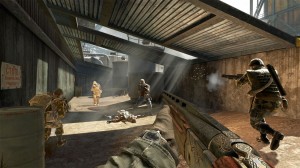Full-Screen Splitscreen on 3D TVs
The clever hack demonstrated in the video above allows passive 3D displays to render fullscreen views for each player in a splitscreen session. This allows both players to enjoy the entire screen area (albeit in 2D only), removing the ability for you or your friend to screen watch. The best part about this hack is that you only need a few items to make it work.
To recreate this effect for yourself, you need:
- Passive 3D TV
- 2 pairs of polarized glasses
- PS3 or Xbox 360 game with 3D capability and split-screen game mode(s)
How does it work?
You simply pop out the lenses in the passive glasses and place the two L lenses in one pair and the R lenses in the other. Now that the lenses match with respect to polarity, you then enable the appropriate 3D modes on both your 3D TV and in the game. It’s that simple.
Call of Duty: Black Ops supports the Top-Bottom 3D format, as do nearly all 3D sets. (Note: Top-Bottom may also be designated ‘Over-Under’ or ‘Above-Below’.) The PS3 console supports a variety of 3D formats, including Top-Bottom, Side-by-Side and Frame Packing, but most PS3 titles to date use Top-Bottom for 3D rendering. The important thing is that both your 3D TV and game match according to 3D mode.
Passive 3D sets typically come with 2-4 pairs of polarized glasses, but if you need some, you can also use the ones from theaters – if you choose not to return them at the end of the presentation. If not, they are very cheap in comparison to active shutter eyewear.
While the X360 does not “officially” support stereoscopic 3D, the console’s hardware is fully capable of rendering 3D gameplay which matches or exceeds the quality of PS3’s S3D output. The 360 does not have as many 3D-compatible titles as PS3 right now, but if you have one, such as Crysis 2, along with a passive 3D set, the effect will work precisely the same way. Simply enable Top-Bottom or Side-by-Side in the game menu and on your 3D TV.
Downsides
Since this hack reverts gameplay to a single view for each player, the 3D effect is lost. The same is true for active 3D implementations, such as Sony’s SimulView. There is no (cost-efficient) way to achieve this effect and 3D simultaneously on a single display.
I should mention that the resolution loss inherent to passive 3D sets will be exacerbated by this hack. For example, let’s take the game used in the video. Call of Duty: Black Ops is rendered on PS3 at a resolution of 960 x 544, which will be scaled to the resolution output you have selected in your PS3’s video settings. In 2D mode, this full resolution is displayed. In 3D mode, however, vertical resolution is halved as a byproduct of polarization, leaving each eye with 960 x 272 pixels of information. By interchanging the lenses as in the video, there are no longer two views later combined by the brain but just one view: a 960 x 272 frame stretched across the area of your display. The end result is certainly not pretty, particularly on a 50″ screen, but mileage may vary as it depends on your screen size-viewing distance setup. And, ultimately, the appeal of this might depend on how much you are enjoying capping your friend who can no longer screen watch to get an edge.
Of note is that the X360 version of Black Ops is rendered slightly higher at 1040 x 608, but this minor increase won’t make the extreme slice in resolution any less palpable.
Sony SimulView
I think it was largely because of this video and its viral effect that led to Sony’s implementation in its active shutter 3D sets. At the moment, Sony’s PS3-branded 3D display is the only active 3D TV with this feature, which Sony has dubbed SimulView. Its “quad speed frame-sequential display technology” essentially alters the way the separate views are transmitted by sending two side by side 2D images, one for each player. The effect is enabled by pressing a button on the top of the glasses. The prime advantage active has over passive in this case is that each player receives full 2D resolution. It’s not halved as in passive sets, where the loss is more pronounced due to the single, uncombined view.
It’s not all perfect, however. Sony only sells a single, 24” model, and it only ships with one pair of glasses. Additional eyewear is around $70. But perhaps the biggest drawback is that games must specifically support this feature, rendering all preexisting titles incompatible unless an update is issued.
I’m sure we’ll see this feature implemented in more active shutter sets down the road (assuming the Sony sells well), but for now, it’s easy to recreate the effect on all passive 3D sets.
For more information on the differences between active and passive 3D technology: The 3D TV War: Which One Should You Buy?



Comments